An Analysis of Legal Aspects and Challenges in Virtual Reality
VerifiedAdded on 2023/05/30
|10
|2004
|195
Report
AI Summary
This report examines the legal and regulatory challenges associated with Virtual Reality (VR) technology. It delves into critical aspects such as data privacy concerns stemming from the collection of personal data during VR experiences, the complexities of patenting and trade secrets within the technologically advanced VR equipment, and the application of Technology Protection Measures (TPM) to protect VR content. The report also addresses regulatory and product liability issues, particularly the risks associated with VR headset usage and the development of content. Furthermore, it explores content licensing agreements, the impact of VR on advertising and medical devices, and the potential reputational risks for organizations. The conclusion emphasizes the need for companies to address these challenges to ensure legal compliance and mitigate potential risks as the VR field continues to evolve.
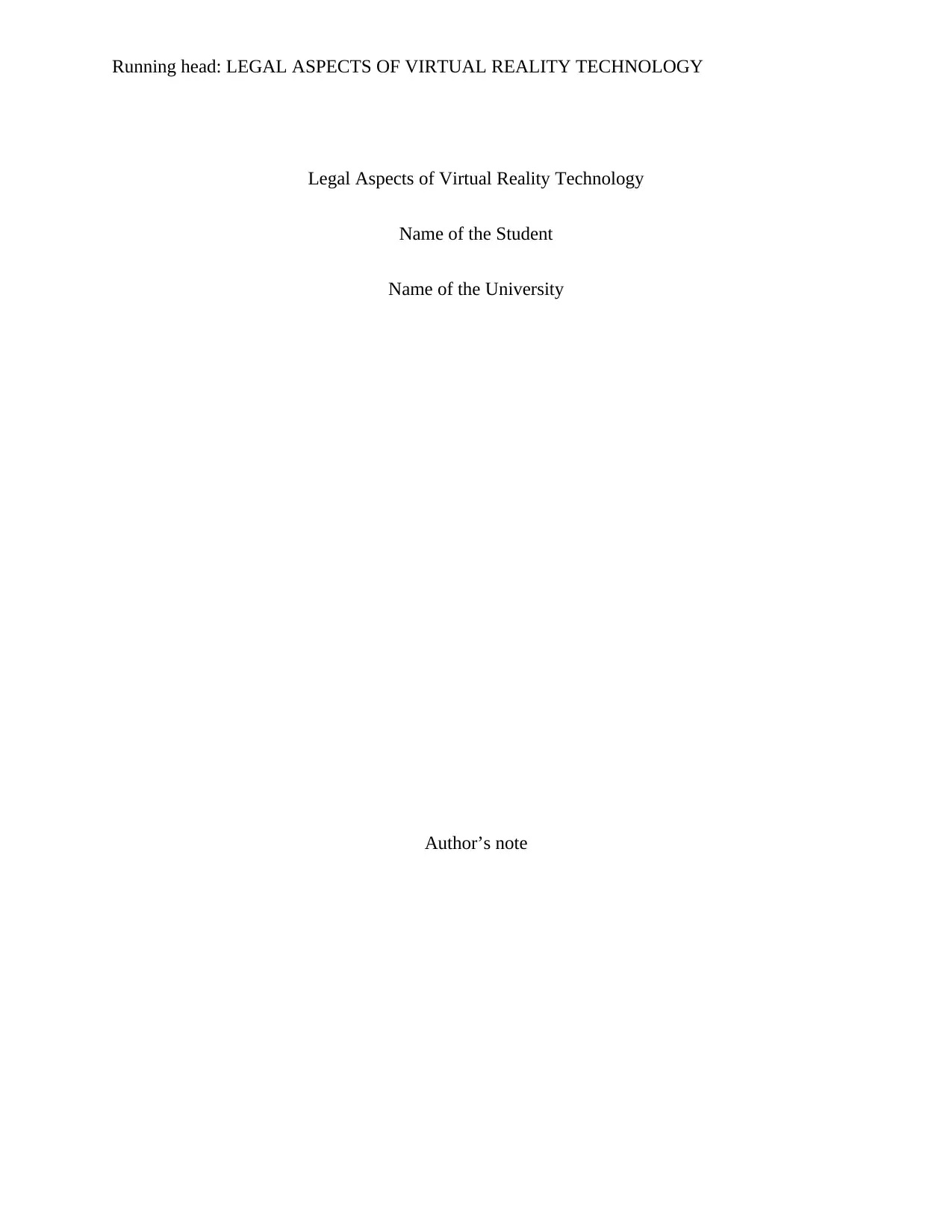
Running head: LEGAL ASPECTS OF VIRTUAL REALITY TECHNOLOGY
Legal Aspects of Virtual Reality Technology
Name of the Student
Name of the University
Author’s note
Legal Aspects of Virtual Reality Technology
Name of the Student
Name of the University
Author’s note
Paraphrase This Document
Need a fresh take? Get an instant paraphrase of this document with our AI Paraphraser
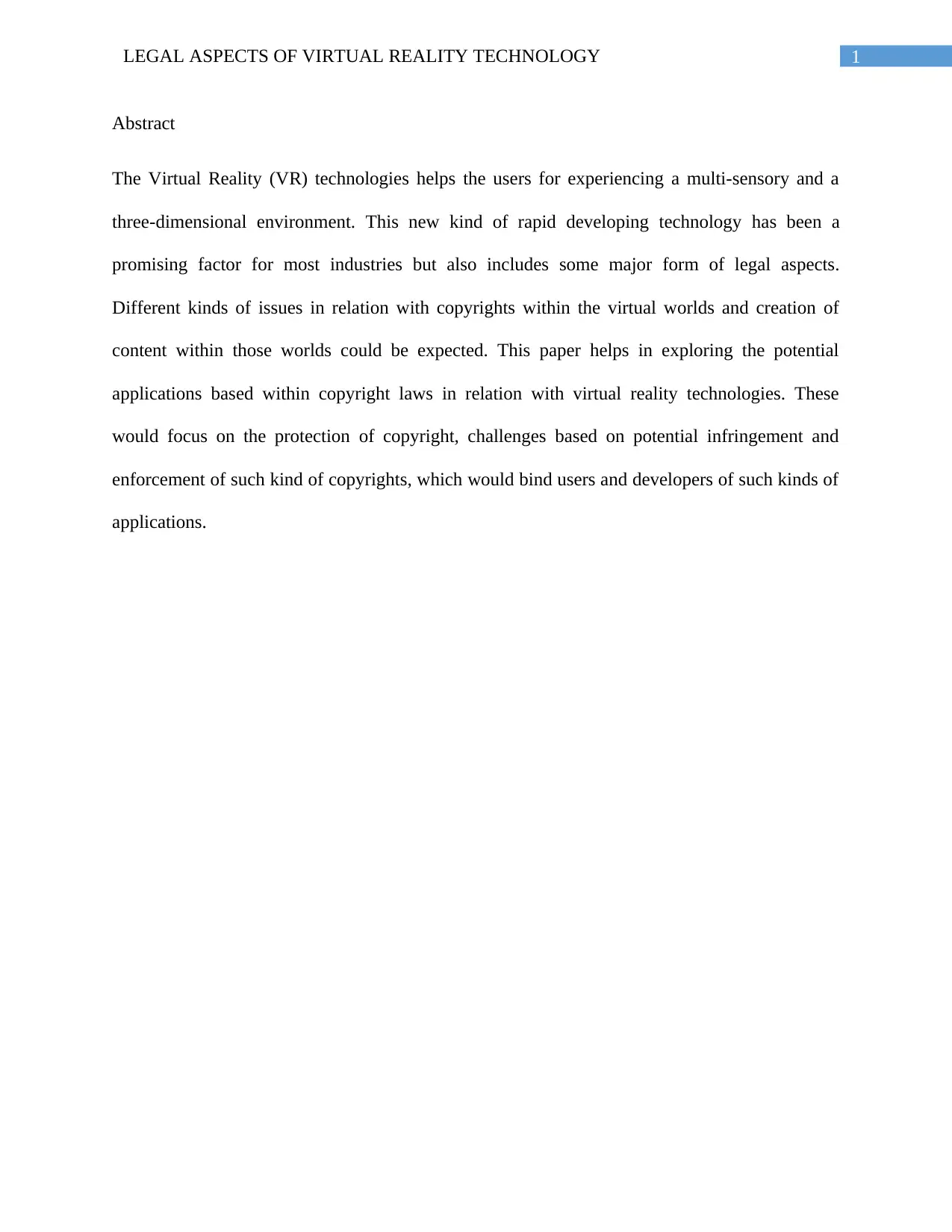
1LEGAL ASPECTS OF VIRTUAL REALITY TECHNOLOGY
Abstract
The Virtual Reality (VR) technologies helps the users for experiencing a multi-sensory and a
three-dimensional environment. This new kind of rapid developing technology has been a
promising factor for most industries but also includes some major form of legal aspects.
Different kinds of issues in relation with copyrights within the virtual worlds and creation of
content within those worlds could be expected. This paper helps in exploring the potential
applications based within copyright laws in relation with virtual reality technologies. These
would focus on the protection of copyright, challenges based on potential infringement and
enforcement of such kind of copyrights, which would bind users and developers of such kinds of
applications.
Abstract
The Virtual Reality (VR) technologies helps the users for experiencing a multi-sensory and a
three-dimensional environment. This new kind of rapid developing technology has been a
promising factor for most industries but also includes some major form of legal aspects.
Different kinds of issues in relation with copyrights within the virtual worlds and creation of
content within those worlds could be expected. This paper helps in exploring the potential
applications based within copyright laws in relation with virtual reality technologies. These
would focus on the protection of copyright, challenges based on potential infringement and
enforcement of such kind of copyrights, which would bind users and developers of such kinds of
applications.
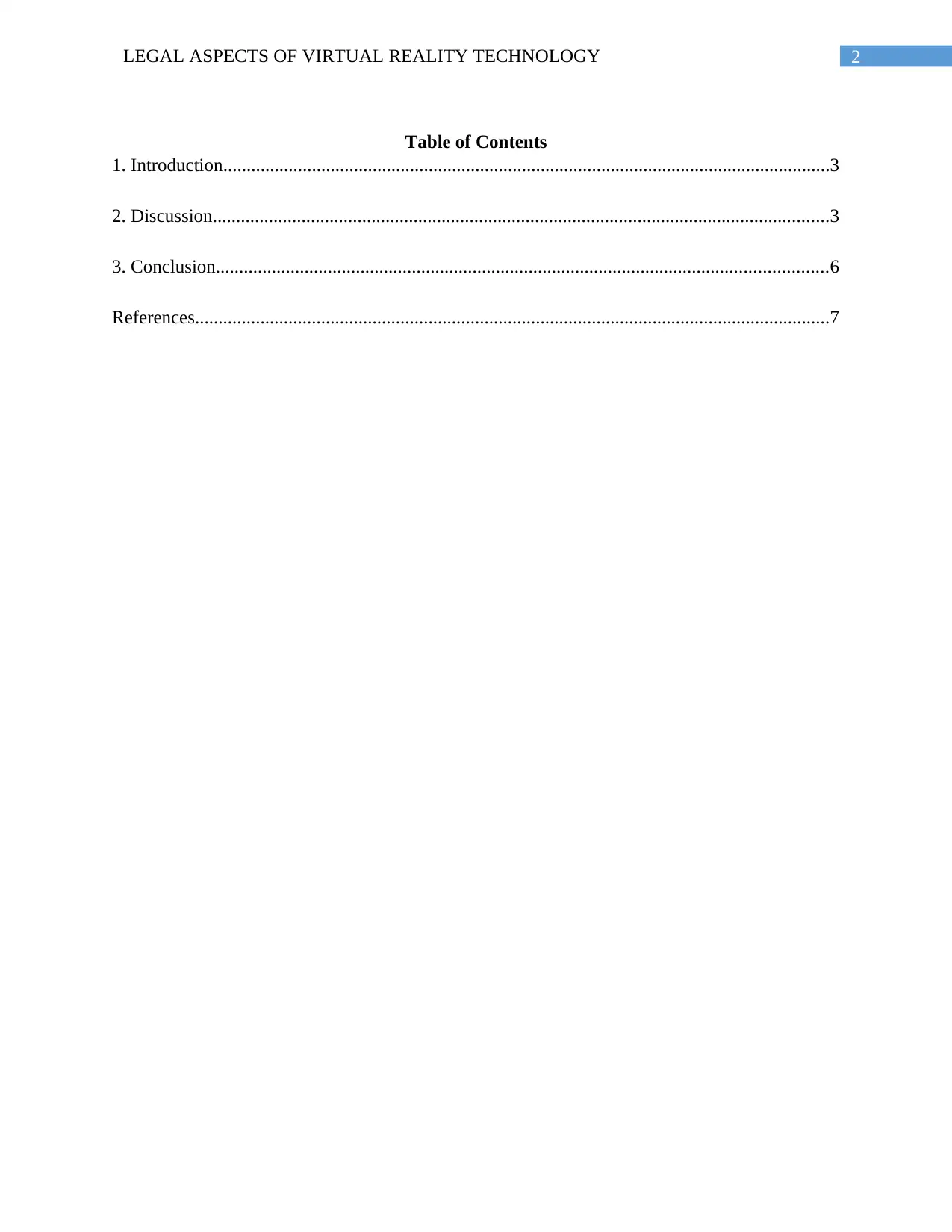
2LEGAL ASPECTS OF VIRTUAL REALITY TECHNOLOGY
Table of Contents
1. Introduction..................................................................................................................................3
2. Discussion....................................................................................................................................3
3. Conclusion...................................................................................................................................6
References........................................................................................................................................7
Table of Contents
1. Introduction..................................................................................................................................3
2. Discussion....................................................................................................................................3
3. Conclusion...................................................................................................................................6
References........................................................................................................................................7
⊘ This is a preview!⊘
Do you want full access?
Subscribe today to unlock all pages.

Trusted by 1+ million students worldwide
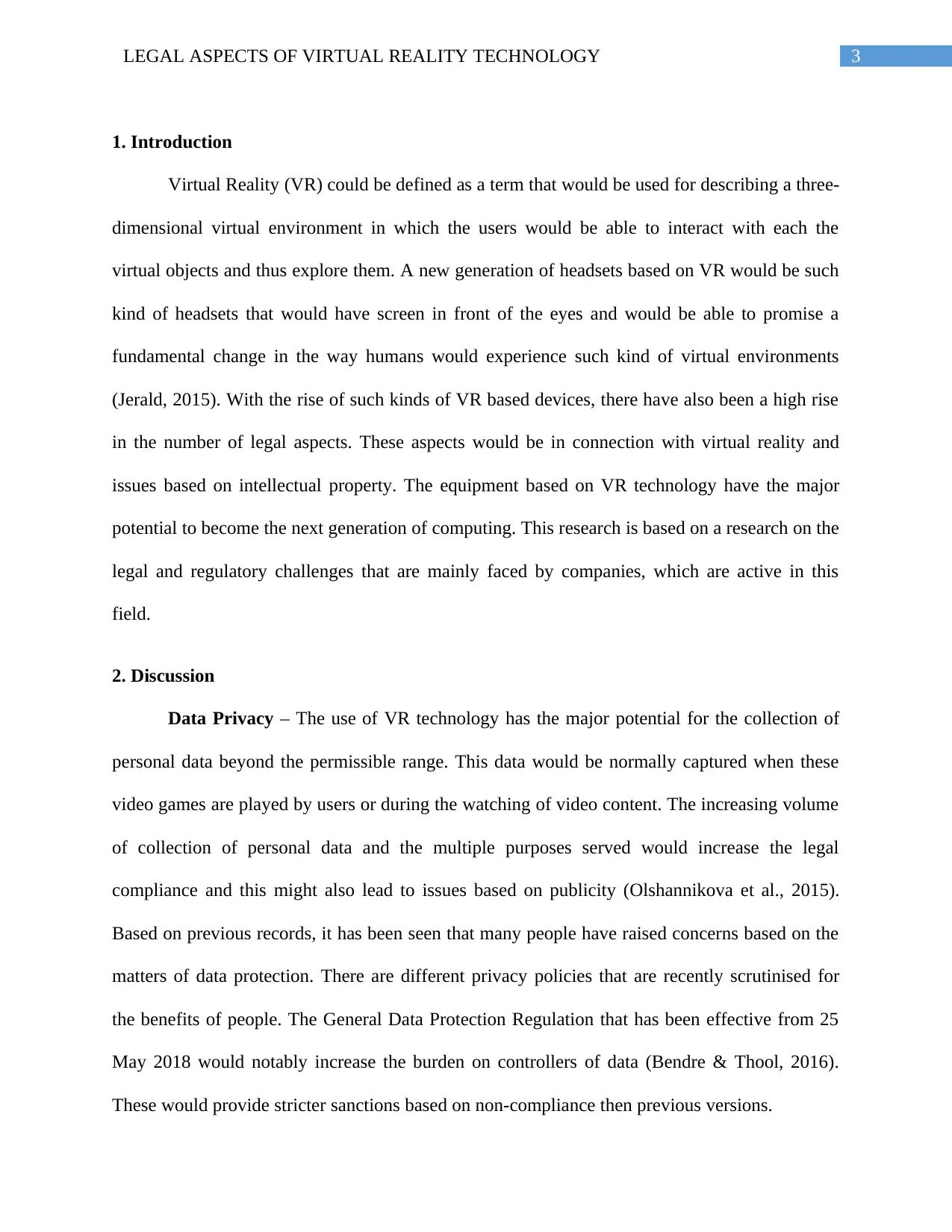
3LEGAL ASPECTS OF VIRTUAL REALITY TECHNOLOGY
1. Introduction
Virtual Reality (VR) could be defined as a term that would be used for describing a three-
dimensional virtual environment in which the users would be able to interact with each the
virtual objects and thus explore them. A new generation of headsets based on VR would be such
kind of headsets that would have screen in front of the eyes and would be able to promise a
fundamental change in the way humans would experience such kind of virtual environments
(Jerald, 2015). With the rise of such kinds of VR based devices, there have also been a high rise
in the number of legal aspects. These aspects would be in connection with virtual reality and
issues based on intellectual property. The equipment based on VR technology have the major
potential to become the next generation of computing. This research is based on a research on the
legal and regulatory challenges that are mainly faced by companies, which are active in this
field.
2. Discussion
Data Privacy – The use of VR technology has the major potential for the collection of
personal data beyond the permissible range. This data would be normally captured when these
video games are played by users or during the watching of video content. The increasing volume
of collection of personal data and the multiple purposes served would increase the legal
compliance and this might also lead to issues based on publicity (Olshannikova et al., 2015).
Based on previous records, it has been seen that many people have raised concerns based on the
matters of data protection. There are different privacy policies that are recently scrutinised for
the benefits of people. The General Data Protection Regulation that has been effective from 25
May 2018 would notably increase the burden on controllers of data (Bendre & Thool, 2016).
These would provide stricter sanctions based on non-compliance then previous versions.
1. Introduction
Virtual Reality (VR) could be defined as a term that would be used for describing a three-
dimensional virtual environment in which the users would be able to interact with each the
virtual objects and thus explore them. A new generation of headsets based on VR would be such
kind of headsets that would have screen in front of the eyes and would be able to promise a
fundamental change in the way humans would experience such kind of virtual environments
(Jerald, 2015). With the rise of such kinds of VR based devices, there have also been a high rise
in the number of legal aspects. These aspects would be in connection with virtual reality and
issues based on intellectual property. The equipment based on VR technology have the major
potential to become the next generation of computing. This research is based on a research on the
legal and regulatory challenges that are mainly faced by companies, which are active in this
field.
2. Discussion
Data Privacy – The use of VR technology has the major potential for the collection of
personal data beyond the permissible range. This data would be normally captured when these
video games are played by users or during the watching of video content. The increasing volume
of collection of personal data and the multiple purposes served would increase the legal
compliance and this might also lead to issues based on publicity (Olshannikova et al., 2015).
Based on previous records, it has been seen that many people have raised concerns based on the
matters of data protection. There are different privacy policies that are recently scrutinised for
the benefits of people. The General Data Protection Regulation that has been effective from 25
May 2018 would notably increase the burden on controllers of data (Bendre & Thool, 2016).
These would provide stricter sanctions based on non-compliance then previous versions.
Paraphrase This Document
Need a fresh take? Get an instant paraphrase of this document with our AI Paraphraser
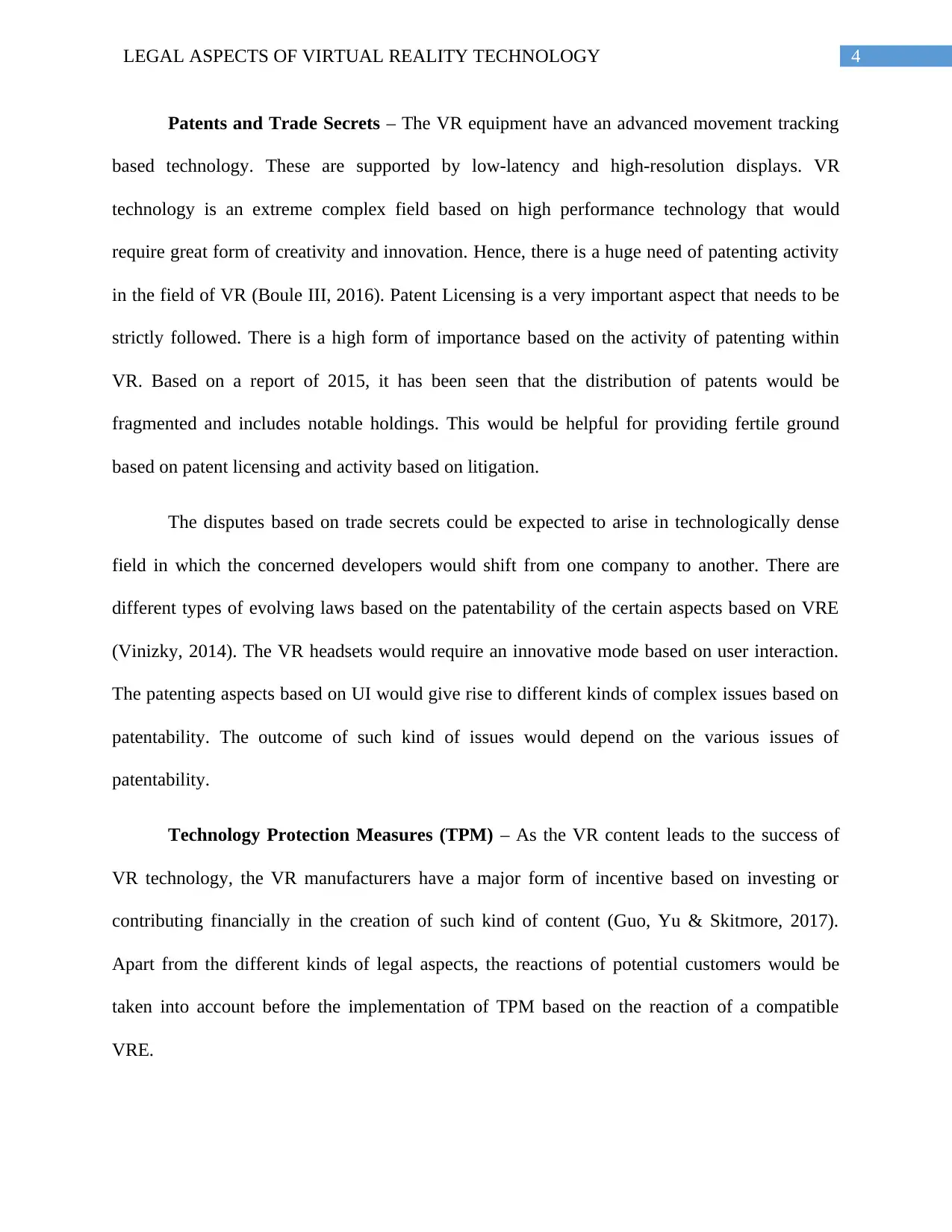
4LEGAL ASPECTS OF VIRTUAL REALITY TECHNOLOGY
Patents and Trade Secrets – The VR equipment have an advanced movement tracking
based technology. These are supported by low-latency and high-resolution displays. VR
technology is an extreme complex field based on high performance technology that would
require great form of creativity and innovation. Hence, there is a huge need of patenting activity
in the field of VR (Boule III, 2016). Patent Licensing is a very important aspect that needs to be
strictly followed. There is a high form of importance based on the activity of patenting within
VR. Based on a report of 2015, it has been seen that the distribution of patents would be
fragmented and includes notable holdings. This would be helpful for providing fertile ground
based on patent licensing and activity based on litigation.
The disputes based on trade secrets could be expected to arise in technologically dense
field in which the concerned developers would shift from one company to another. There are
different types of evolving laws based on the patentability of the certain aspects based on VRE
(Vinizky, 2014). The VR headsets would require an innovative mode based on user interaction.
The patenting aspects based on UI would give rise to different kinds of complex issues based on
patentability. The outcome of such kind of issues would depend on the various issues of
patentability.
Technology Protection Measures (TPM) – As the VR content leads to the success of
VR technology, the VR manufacturers have a major form of incentive based on investing or
contributing financially in the creation of such kind of content (Guo, Yu & Skitmore, 2017).
Apart from the different kinds of legal aspects, the reactions of potential customers would be
taken into account before the implementation of TPM based on the reaction of a compatible
VRE.
Patents and Trade Secrets – The VR equipment have an advanced movement tracking
based technology. These are supported by low-latency and high-resolution displays. VR
technology is an extreme complex field based on high performance technology that would
require great form of creativity and innovation. Hence, there is a huge need of patenting activity
in the field of VR (Boule III, 2016). Patent Licensing is a very important aspect that needs to be
strictly followed. There is a high form of importance based on the activity of patenting within
VR. Based on a report of 2015, it has been seen that the distribution of patents would be
fragmented and includes notable holdings. This would be helpful for providing fertile ground
based on patent licensing and activity based on litigation.
The disputes based on trade secrets could be expected to arise in technologically dense
field in which the concerned developers would shift from one company to another. There are
different types of evolving laws based on the patentability of the certain aspects based on VRE
(Vinizky, 2014). The VR headsets would require an innovative mode based on user interaction.
The patenting aspects based on UI would give rise to different kinds of complex issues based on
patentability. The outcome of such kind of issues would depend on the various issues of
patentability.
Technology Protection Measures (TPM) – As the VR content leads to the success of
VR technology, the VR manufacturers have a major form of incentive based on investing or
contributing financially in the creation of such kind of content (Guo, Yu & Skitmore, 2017).
Apart from the different kinds of legal aspects, the reactions of potential customers would be
taken into account before the implementation of TPM based on the reaction of a compatible
VRE.
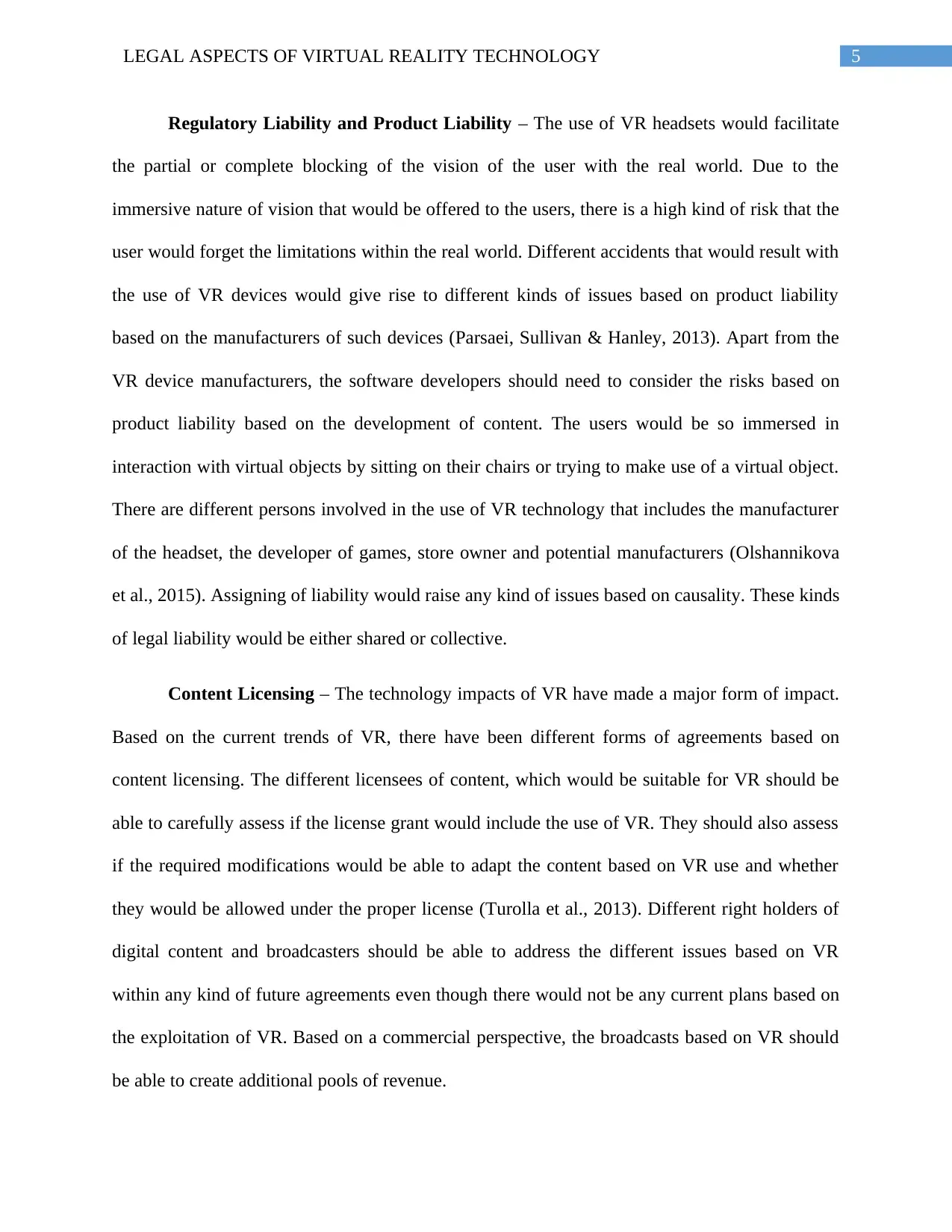
5LEGAL ASPECTS OF VIRTUAL REALITY TECHNOLOGY
Regulatory Liability and Product Liability – The use of VR headsets would facilitate
the partial or complete blocking of the vision of the user with the real world. Due to the
immersive nature of vision that would be offered to the users, there is a high kind of risk that the
user would forget the limitations within the real world. Different accidents that would result with
the use of VR devices would give rise to different kinds of issues based on product liability
based on the manufacturers of such devices (Parsaei, Sullivan & Hanley, 2013). Apart from the
VR device manufacturers, the software developers should need to consider the risks based on
product liability based on the development of content. The users would be so immersed in
interaction with virtual objects by sitting on their chairs or trying to make use of a virtual object.
There are different persons involved in the use of VR technology that includes the manufacturer
of the headset, the developer of games, store owner and potential manufacturers (Olshannikova
et al., 2015). Assigning of liability would raise any kind of issues based on causality. These kinds
of legal liability would be either shared or collective.
Content Licensing – The technology impacts of VR have made a major form of impact.
Based on the current trends of VR, there have been different forms of agreements based on
content licensing. The different licensees of content, which would be suitable for VR should be
able to carefully assess if the license grant would include the use of VR. They should also assess
if the required modifications would be able to adapt the content based on VR use and whether
they would be allowed under the proper license (Turolla et al., 2013). Different right holders of
digital content and broadcasters should be able to address the different issues based on VR
within any kind of future agreements even though there would not be any current plans based on
the exploitation of VR. Based on a commercial perspective, the broadcasts based on VR should
be able to create additional pools of revenue.
Regulatory Liability and Product Liability – The use of VR headsets would facilitate
the partial or complete blocking of the vision of the user with the real world. Due to the
immersive nature of vision that would be offered to the users, there is a high kind of risk that the
user would forget the limitations within the real world. Different accidents that would result with
the use of VR devices would give rise to different kinds of issues based on product liability
based on the manufacturers of such devices (Parsaei, Sullivan & Hanley, 2013). Apart from the
VR device manufacturers, the software developers should need to consider the risks based on
product liability based on the development of content. The users would be so immersed in
interaction with virtual objects by sitting on their chairs or trying to make use of a virtual object.
There are different persons involved in the use of VR technology that includes the manufacturer
of the headset, the developer of games, store owner and potential manufacturers (Olshannikova
et al., 2015). Assigning of liability would raise any kind of issues based on causality. These kinds
of legal liability would be either shared or collective.
Content Licensing – The technology impacts of VR have made a major form of impact.
Based on the current trends of VR, there have been different forms of agreements based on
content licensing. The different licensees of content, which would be suitable for VR should be
able to carefully assess if the license grant would include the use of VR. They should also assess
if the required modifications would be able to adapt the content based on VR use and whether
they would be allowed under the proper license (Turolla et al., 2013). Different right holders of
digital content and broadcasters should be able to address the different issues based on VR
within any kind of future agreements even though there would not be any current plans based on
the exploitation of VR. Based on a commercial perspective, the broadcasts based on VR should
be able to create additional pools of revenue.
⊘ This is a preview!⊘
Do you want full access?
Subscribe today to unlock all pages.

Trusted by 1+ million students worldwide
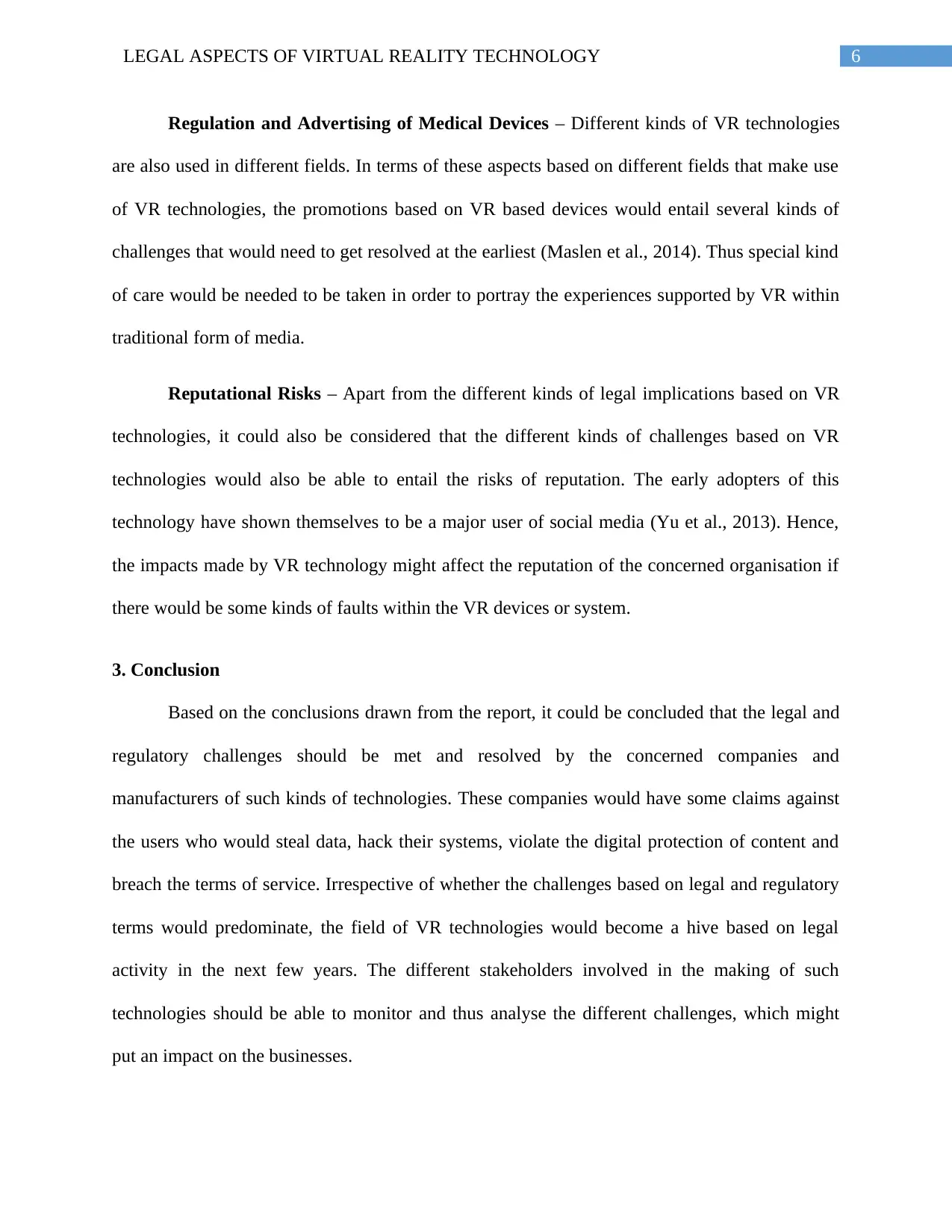
6LEGAL ASPECTS OF VIRTUAL REALITY TECHNOLOGY
Regulation and Advertising of Medical Devices – Different kinds of VR technologies
are also used in different fields. In terms of these aspects based on different fields that make use
of VR technologies, the promotions based on VR based devices would entail several kinds of
challenges that would need to get resolved at the earliest (Maslen et al., 2014). Thus special kind
of care would be needed to be taken in order to portray the experiences supported by VR within
traditional form of media.
Reputational Risks – Apart from the different kinds of legal implications based on VR
technologies, it could also be considered that the different kinds of challenges based on VR
technologies would also be able to entail the risks of reputation. The early adopters of this
technology have shown themselves to be a major user of social media (Yu et al., 2013). Hence,
the impacts made by VR technology might affect the reputation of the concerned organisation if
there would be some kinds of faults within the VR devices or system.
3. Conclusion
Based on the conclusions drawn from the report, it could be concluded that the legal and
regulatory challenges should be met and resolved by the concerned companies and
manufacturers of such kinds of technologies. These companies would have some claims against
the users who would steal data, hack their systems, violate the digital protection of content and
breach the terms of service. Irrespective of whether the challenges based on legal and regulatory
terms would predominate, the field of VR technologies would become a hive based on legal
activity in the next few years. The different stakeholders involved in the making of such
technologies should be able to monitor and thus analyse the different challenges, which might
put an impact on the businesses.
Regulation and Advertising of Medical Devices – Different kinds of VR technologies
are also used in different fields. In terms of these aspects based on different fields that make use
of VR technologies, the promotions based on VR based devices would entail several kinds of
challenges that would need to get resolved at the earliest (Maslen et al., 2014). Thus special kind
of care would be needed to be taken in order to portray the experiences supported by VR within
traditional form of media.
Reputational Risks – Apart from the different kinds of legal implications based on VR
technologies, it could also be considered that the different kinds of challenges based on VR
technologies would also be able to entail the risks of reputation. The early adopters of this
technology have shown themselves to be a major user of social media (Yu et al., 2013). Hence,
the impacts made by VR technology might affect the reputation of the concerned organisation if
there would be some kinds of faults within the VR devices or system.
3. Conclusion
Based on the conclusions drawn from the report, it could be concluded that the legal and
regulatory challenges should be met and resolved by the concerned companies and
manufacturers of such kinds of technologies. These companies would have some claims against
the users who would steal data, hack their systems, violate the digital protection of content and
breach the terms of service. Irrespective of whether the challenges based on legal and regulatory
terms would predominate, the field of VR technologies would become a hive based on legal
activity in the next few years. The different stakeholders involved in the making of such
technologies should be able to monitor and thus analyse the different challenges, which might
put an impact on the businesses.
Paraphrase This Document
Need a fresh take? Get an instant paraphrase of this document with our AI Paraphraser
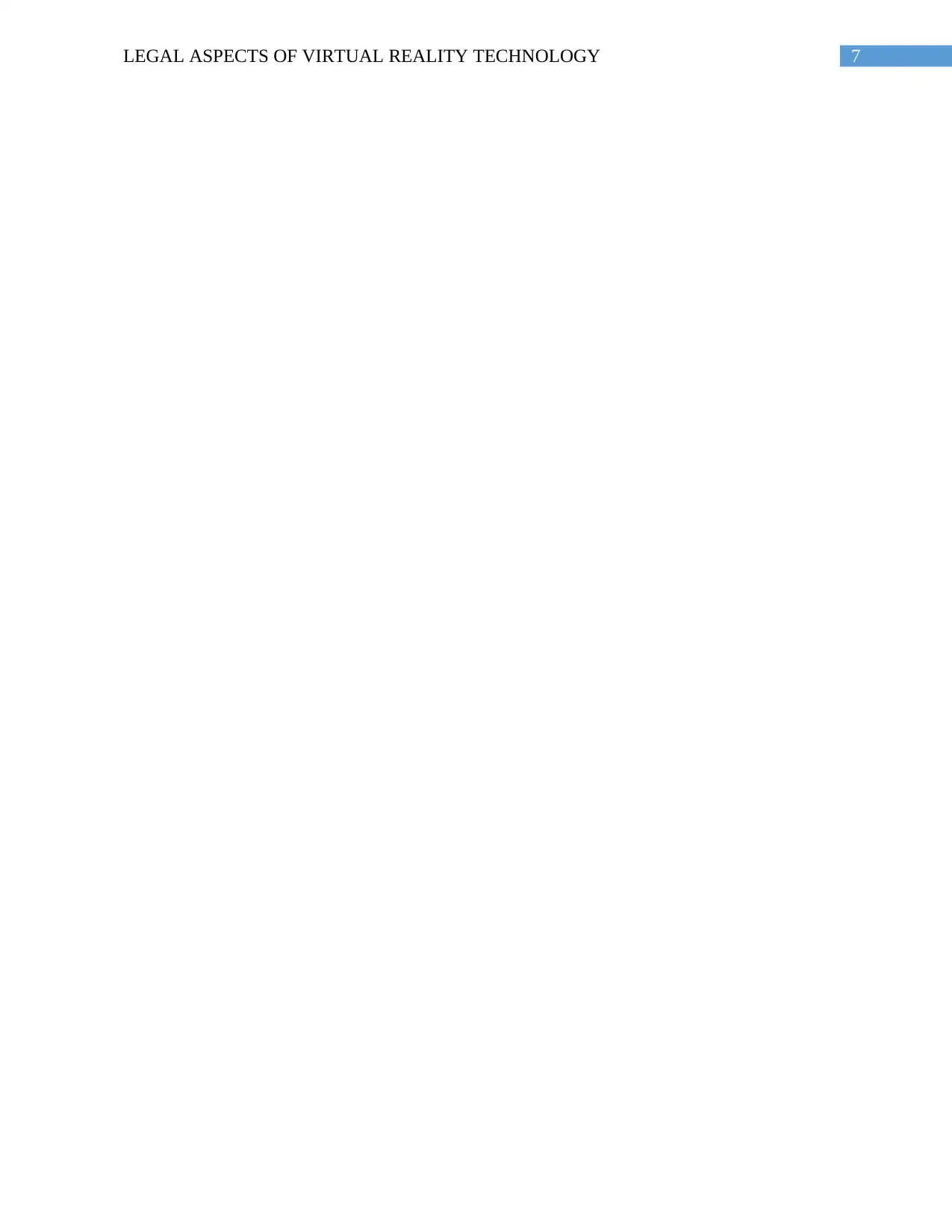
7LEGAL ASPECTS OF VIRTUAL REALITY TECHNOLOGY
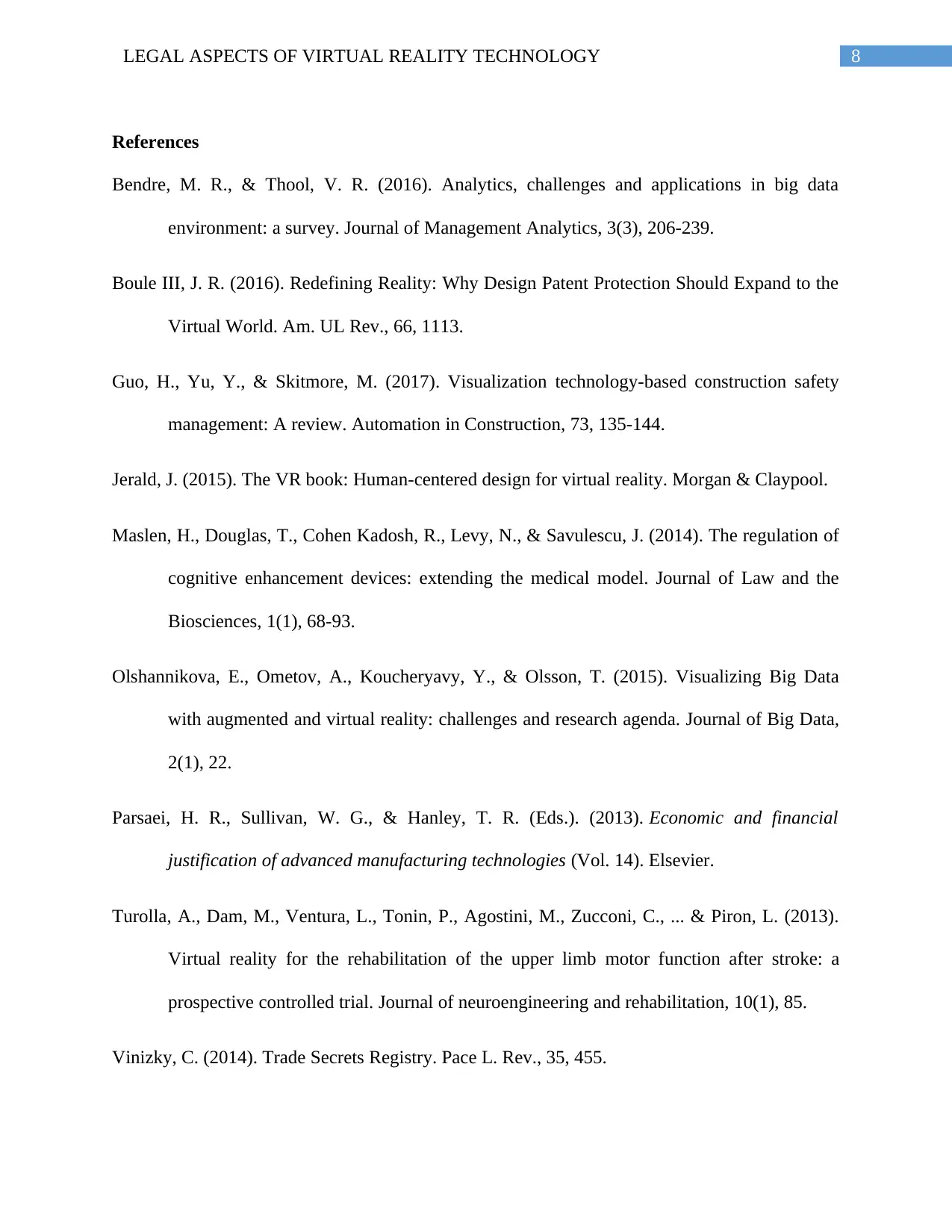
8LEGAL ASPECTS OF VIRTUAL REALITY TECHNOLOGY
References
Bendre, M. R., & Thool, V. R. (2016). Analytics, challenges and applications in big data
environment: a survey. Journal of Management Analytics, 3(3), 206-239.
Boule III, J. R. (2016). Redefining Reality: Why Design Patent Protection Should Expand to the
Virtual World. Am. UL Rev., 66, 1113.
Guo, H., Yu, Y., & Skitmore, M. (2017). Visualization technology-based construction safety
management: A review. Automation in Construction, 73, 135-144.
Jerald, J. (2015). The VR book: Human-centered design for virtual reality. Morgan & Claypool.
Maslen, H., Douglas, T., Cohen Kadosh, R., Levy, N., & Savulescu, J. (2014). The regulation of
cognitive enhancement devices: extending the medical model. Journal of Law and the
Biosciences, 1(1), 68-93.
Olshannikova, E., Ometov, A., Koucheryavy, Y., & Olsson, T. (2015). Visualizing Big Data
with augmented and virtual reality: challenges and research agenda. Journal of Big Data,
2(1), 22.
Parsaei, H. R., Sullivan, W. G., & Hanley, T. R. (Eds.). (2013). Economic and financial
justification of advanced manufacturing technologies (Vol. 14). Elsevier.
Turolla, A., Dam, M., Ventura, L., Tonin, P., Agostini, M., Zucconi, C., ... & Piron, L. (2013).
Virtual reality for the rehabilitation of the upper limb motor function after stroke: a
prospective controlled trial. Journal of neuroengineering and rehabilitation, 10(1), 85.
Vinizky, C. (2014). Trade Secrets Registry. Pace L. Rev., 35, 455.
References
Bendre, M. R., & Thool, V. R. (2016). Analytics, challenges and applications in big data
environment: a survey. Journal of Management Analytics, 3(3), 206-239.
Boule III, J. R. (2016). Redefining Reality: Why Design Patent Protection Should Expand to the
Virtual World. Am. UL Rev., 66, 1113.
Guo, H., Yu, Y., & Skitmore, M. (2017). Visualization technology-based construction safety
management: A review. Automation in Construction, 73, 135-144.
Jerald, J. (2015). The VR book: Human-centered design for virtual reality. Morgan & Claypool.
Maslen, H., Douglas, T., Cohen Kadosh, R., Levy, N., & Savulescu, J. (2014). The regulation of
cognitive enhancement devices: extending the medical model. Journal of Law and the
Biosciences, 1(1), 68-93.
Olshannikova, E., Ometov, A., Koucheryavy, Y., & Olsson, T. (2015). Visualizing Big Data
with augmented and virtual reality: challenges and research agenda. Journal of Big Data,
2(1), 22.
Parsaei, H. R., Sullivan, W. G., & Hanley, T. R. (Eds.). (2013). Economic and financial
justification of advanced manufacturing technologies (Vol. 14). Elsevier.
Turolla, A., Dam, M., Ventura, L., Tonin, P., Agostini, M., Zucconi, C., ... & Piron, L. (2013).
Virtual reality for the rehabilitation of the upper limb motor function after stroke: a
prospective controlled trial. Journal of neuroengineering and rehabilitation, 10(1), 85.
Vinizky, C. (2014). Trade Secrets Registry. Pace L. Rev., 35, 455.
⊘ This is a preview!⊘
Do you want full access?
Subscribe today to unlock all pages.

Trusted by 1+ million students worldwide
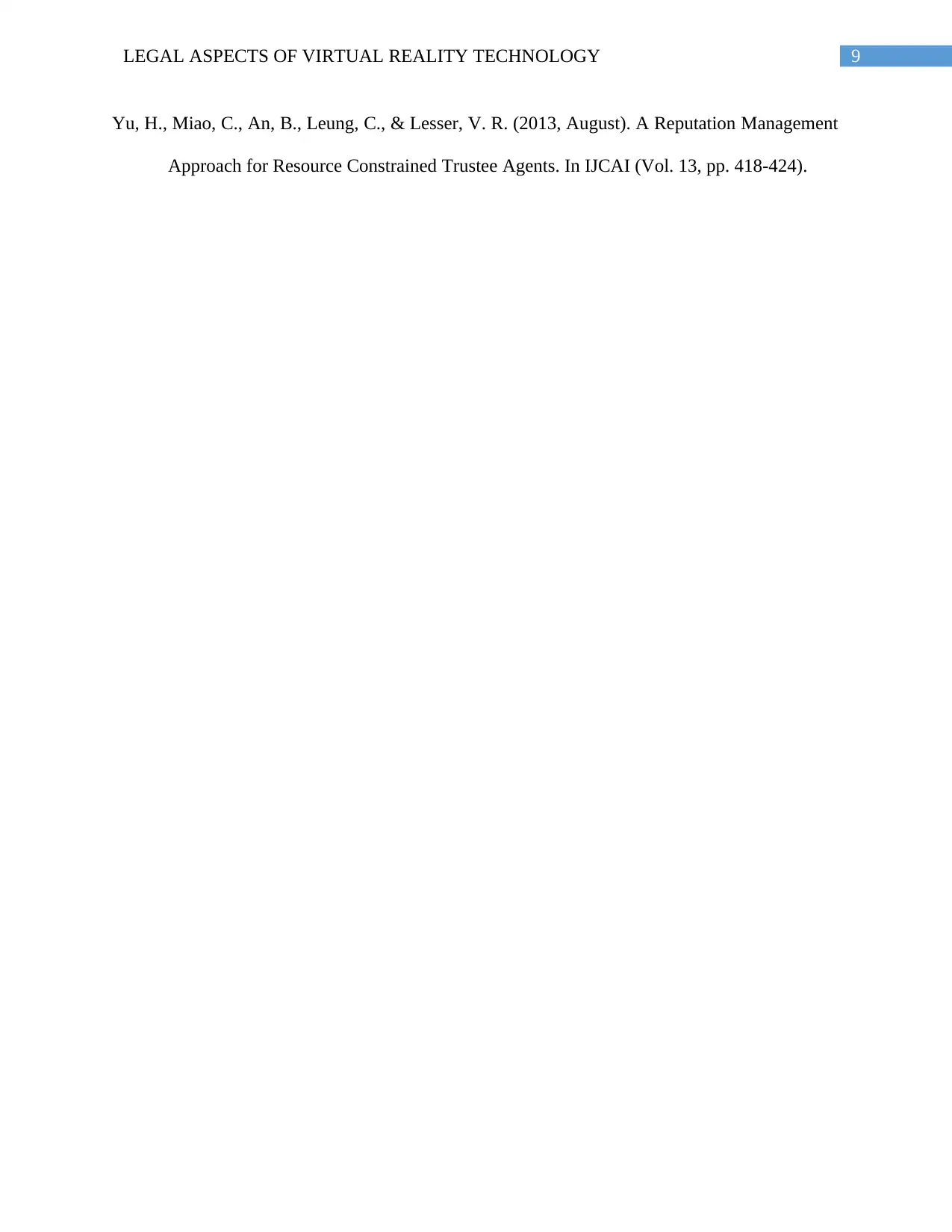
9LEGAL ASPECTS OF VIRTUAL REALITY TECHNOLOGY
Yu, H., Miao, C., An, B., Leung, C., & Lesser, V. R. (2013, August). A Reputation Management
Approach for Resource Constrained Trustee Agents. In IJCAI (Vol. 13, pp. 418-424).
Yu, H., Miao, C., An, B., Leung, C., & Lesser, V. R. (2013, August). A Reputation Management
Approach for Resource Constrained Trustee Agents. In IJCAI (Vol. 13, pp. 418-424).
1 out of 10
Related Documents
Your All-in-One AI-Powered Toolkit for Academic Success.
+13062052269
info@desklib.com
Available 24*7 on WhatsApp / Email
![[object Object]](/_next/static/media/star-bottom.7253800d.svg)
Unlock your academic potential
Copyright © 2020–2025 A2Z Services. All Rights Reserved. Developed and managed by ZUCOL.




